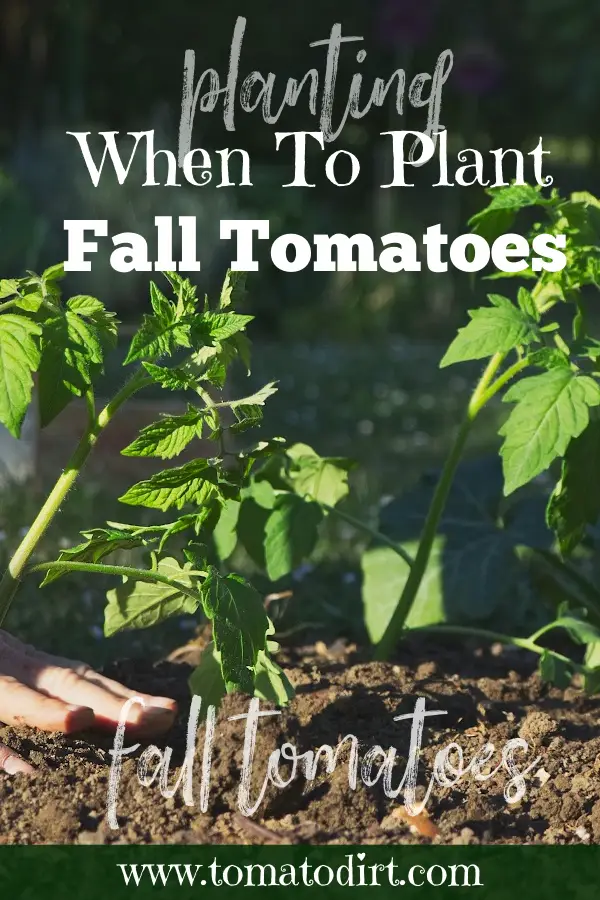FREE: 10 Must-Know Tomato Growing Tips Get The Guide
Read our affiliate disclosure here.
When Should You Plant Fall Tomatoes?
Since 2010, Tomato Dirt has garnered 4.8+ million views, making it the web’s leading online source for growing tomatoes in the home garden. Award-winning writer and Tomato Dirt owner Kathy Widenhouse has helped thousands of home gardeners grow healthier tomatoes. Be one of them when you get Tomato Dirt’s Growing Guide here.
If you plant fall tomatoes in your home garden, you can extend your growing season. But when should you plant yours? The timing can vary depending on your specific location and climate.
A general guideline for when to plant fall tomatoes
Most tomato plants produce their first fruits after 60-75 days, provided the temperatures stay above 50°F at night and below 90°F during the day while plants are growing.
As a general guideline, plant fall tomatoes about 10-12 weeks (70-85 days) before the last expect frost date in your area. That allows for the necessary tomato growing window – giving plants enough time to mature and produce fruit before the true cold sets in – with a bit of padding thrown in, just in case.
How to calculate when to plant your fall tomatoes
To determine the ideal planting date for your fall tomatoes, you need to know the average date of the first frost in your area. If you’re not familiar with this data, check with your local agricultural extension offices or a garden center in your area. In North America, you can get a general idea of your last frost date by checking the USDA Hardiness Zone map.
An example of when to plant fall tomatoes
Let’s look at an example: when to plant fall tomatoes in Houston, Texas. That Gulf Coast city is in Zone 9a of the USDA Hardiness Zone map … or even 8b, if you live north of the city.
- The last frost date for Zone 8: November 7
- The last frost date for Zone 9: November 25
Let’s be conservative and allow our fall tomatoes 85 days to maturity. That allows for extra wiggle room if you choosing a longer-maturing variety or if your weather is unseasonably cool for a few days or a week.
With that in mind, here’s when to plant fall tomatoes in Houston …
- In Zone 8: August 14
- In Zone 9: September 1
You can use the same principle to calculate when to plant fall tomatoes in Louisiana or Oklahoma or Florida … or Melbourne, Australia.
Before you plant fall tomatoes, consider these tips
1. Choose the variety carefully.
Unless you live in a subtropical or tropical climate, consider tomatoes that have a shorter maturity period (versus long season tomatoes) – that is, around 60 to 80 days.
This gives plants enough time to produce fruit before the frost arrives. You can also choose large, more developed seedlings from the garden centers to give your fall tomato crop a head start. Among the best tomato varieties to plant in the fall are cherry tomatoes, because they blossom and ripen so much more quickly than beefsteaks.
2. Keep the soil warm.
Tomatoes thrive in heat. Before planting a fall crop, make sure that the daytime temperatures in your area will remain consistently above 50°F (10°C) during your fall growing season – to include overnight.
You can keep the soil warm by covering the soil with black plastic before planting. The dark color absorbs heat and retains it when the air gets cool in the evenings. As cold temperatures approach, you can offer your tomato plants some protection overnight to shield them from cool air, such as row covers or cloches.
3. Protect seedlings from transplant shock.
Early in the season, you may have the opposite problem: too much heat. Tomatoes struggle to set fruit when the thermometer rises above 90°F (32°C). Plus, seedlings may falter or wilt from transplant shock or if placed in the direct sunlight.
Alleviate their stress in two ways. First, plant when the weather is cloudy or overcast. And help your fall tomato plants get a good start by offering shade protection during the heat of the day.
And second, follow watering guidelines for planting any new tomato crop. Give each plant at least a quart of water each day, more if the weather is especially warm, during the first 7-14 days. After that, plants should get 1-3 inches a week of water (including rainwater) – closer to 1 inch if the weather is cool, closer to 3 inches if temperatures are hot. On average, each plant should get 2 gallons of water a week.
Plant tomatoes in the fall and enjoy a longer season
Fall is a good time for growing a second tomato crop. By late season, pests have died off and excessively hot summer temperatures simmer down to glorious autumn days.
Give your second season tomatoes a good start by planting them at the right time. Do that, and you’ll have plenty tomatoes to harvest well into the fall. And soon after that, it will be time to plan your spring garden.
More about growing fall tomatoes
How to extend your harvest of homegrown tomatoes ...
Choosing fall tomato varieties to extend your harvest ...
How to take fall tomato cuttings to grow late tomatoes ...
3 keys to growing fall tomatoes successfully ...
More tips for growing fall tomatoes ...
More on our Late Season Tomatoes Pinterest Board ...
Return from When Should You Plant Fall Tomatoes?
to Tomato Dirt home
As an Amazon Associate and Rakuten Advertising affiliate I earn from qualifying purchases.
SHARE THIS PAGE:
FREE! 10 Must-Know Tomato Growing Tips: 20-page guide
Get yours here:




